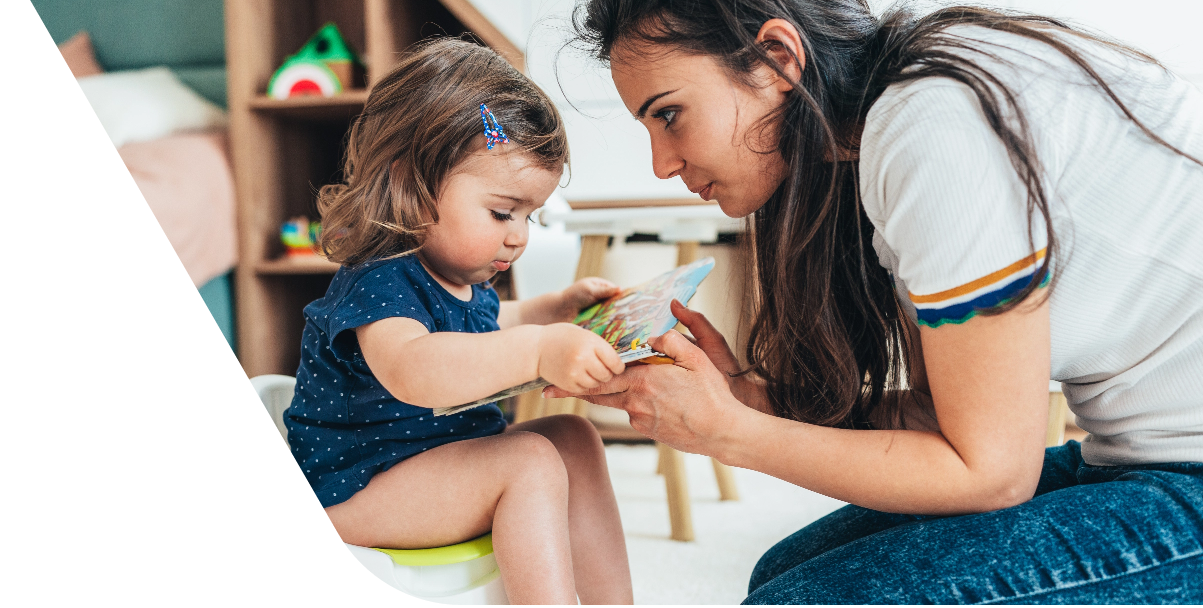Figure out if your child is ready:
- Diaper is dry for several consecutive hours
- Able to sit on the toilet without losing balance
- Can follow simple instructions and have the ability to let you know when to use the potty
Prepare your child (and yourself)
- First and foremost, put your potty in the bathroom your child uses the most, and show them where it lives.
- If your child is showing signs of needing the toilet, such as tugging at their diaper or telling you with their words, always go with them to the bathroom.
- Dress your little one in clothes that are easy to pull up and down. Complicated zippers or buttons will only be frustrating for them (and you) during those last-minute toilet dashes, so elasticated waists are your friend right now!
Start a routine
Follow a few simple steps, so that your child can familiarise themselves with everything.
- Let your child sit fully clothed on the potty.
- When your child feels comfortable sitting on the potty for longer than a few seconds, start taking them to the potty at regular intervals during the day.
- Continue this new routine by visiting the potty with your child at specific times every day. These times could include immediately after your child wakes up, after mealtimes, and before naps and bedtime. If your child urinates or has a bowel movement on the toilet, make sure to praise them! This will positively reinforce them to use the potty.
- At the point that you feel your child has used the potty successfully a few times, you could try putting them in underpants. Show your toddler that this is a special moment for them!
Mind your language
Straightforward language for body parts and body fluids will help your toddler to avoid any confusion, especially if they’re in preschool or other childcare, and need to communicate their wants and needs to someone else. Avoid attaching any negative words such as ‘yucky’ or ‘gross’ to pee or poop, as this might make a child more likely to feel bad about going to the toilet.
Be patient – and praise
Rewards can come in the form of plenty of encouraging words. And when accidents do happen (which they inevitably will) try not to scold your child. Just change their clothes, and explain that pees and poops should be done on the potty.
Potty training boys
While you can approach potty training in much the same way for boys as for girls, boys usually pee standing up once they’ve become familiar with going to the toilet while sitting down.
Can constipation interfere with potty training?
It’s a good idea to keep an eye on your toddler’s bowel movements. Constipation can cause little ones to avoid pooping as passing hard stools can be painful. If you’re worried that your child might have constipation, talk to your doctor about what you can do. It may be that a little more fiber is needed in your child’s diet. Once the cause of any toilet training issue is identified, you can better manage it, meaning you’re far more likely to have success!
And if you feel like you’re failing at potty training…
Try not to be disappointed. Every child is different, and readiness for potty training varies. There will inevitably be days where you feel your little one is having more accidents than triumphs. It can be particularly stressful and tiring if you feel like you’re having to follow your child around all day. Maybe your child is simply not quite ready, or perhaps they’re understandably taking time to get used to the transition.
Whatever your concerns, try not to rush your child into using the potty. If they refuse it, take a break from the training for a while and revisit when you both feel more ready. If you have concerns about your child’s potty training, please talk to your health care provider.






